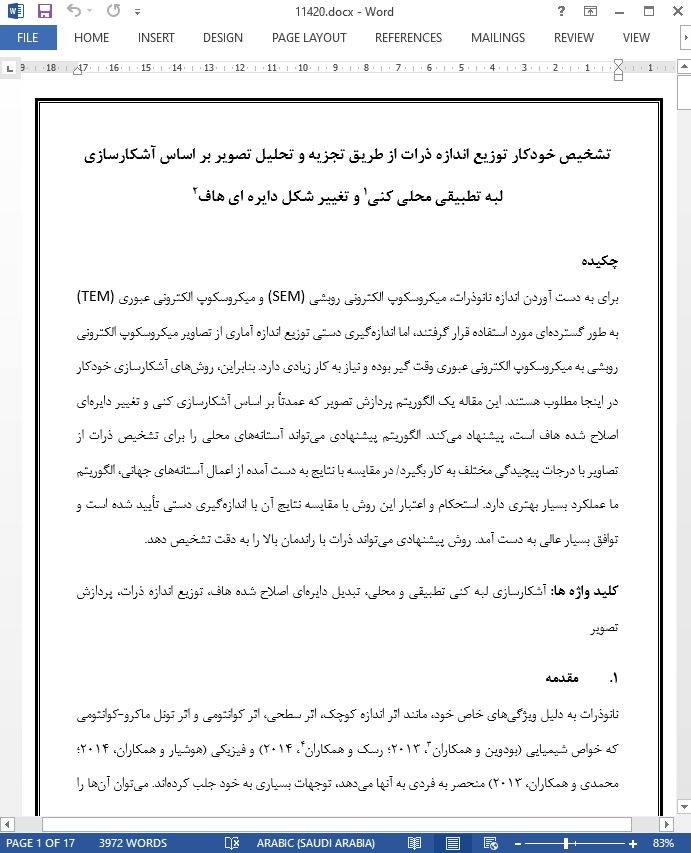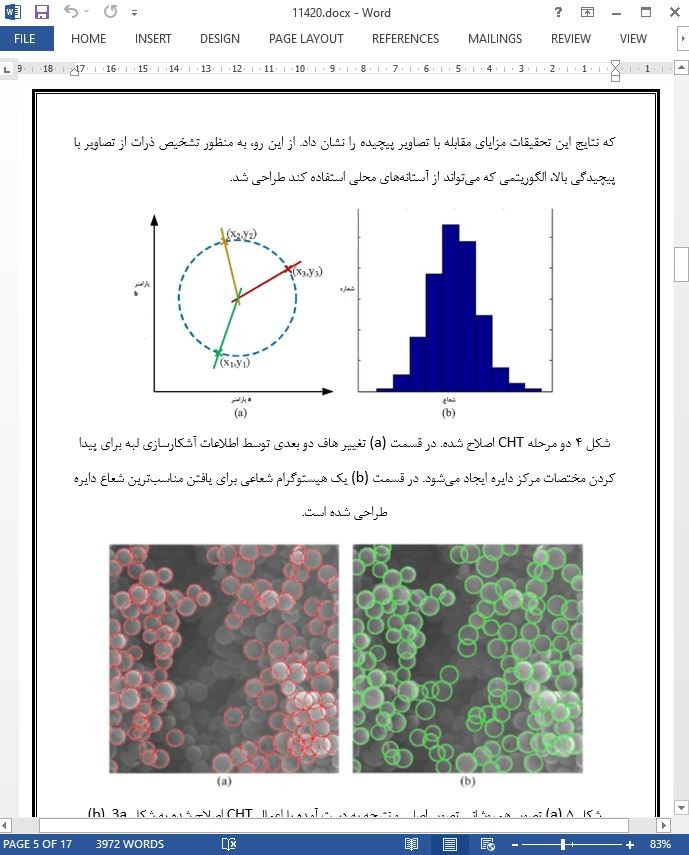
تشخیص خودکار توزیع اندازه ذرات از طریق تجزیه و تحلیل تصویر
چکیده
برای به دست آوردن اندازه نانوذرات، میکروسکوپ الکترونی روبشی (SEM) و میکروسکوپ الکترونی عبوری (TEM) به طور گستردهای مورد استفاده قرار گرفتند، اما اندازهگیری دستی توزیع اندازه آماری از تصاویر میکروسکوپ الکترونی روبشی به میکروسکوپ الکترونی عبوری وقت گیر بوده و نیاز به کار زیادی دارد. بنابراین، روشهای آشکارسازی خودکار در اینجا مطلوب هستند. این مقاله یک الگوریتم پردازش تصویر که عمدتاً بر اساس آشکارسازی کنی و تغییر دایرهای اصلاح شده هاف است، پیشنهاد میکند. الگوریتم پیشنهادی میتواند آستانههای محلی را برای تشخیص ذرات از تصاویر با درجات پیچیدگی مختلف به کار بگیرد/ در مقایسه با نتایج به دست آمده از اعمال آستانههای جهانی، الگوریتم ما عملکرد بسیار بهتری دارد. استحکام و اعتبار این روش با مقایسه نتایج آن با اندازهگیری دستی تأیید شده است و توافق بسیار عالی به دست آمد. روش پیشنهادی میتواند ذرات با راندمان بالا را به دقت تشخیص دهد.
1. مقدمه
نانوذرات به دلیل ویژگیهای خاص خود، مانند اثر اندازه کوچک، اثر سطحی، اثر کوانتومی و اثر تونل ماکرو-کوانتومی که خواص شیمیایی (بودوین و همکاران ، 2013؛ رسک و همکاران ، 2014) و فیزیکی (هوشیار و همکاران، 2014؛ محمدی و همکاران، 2013) منحصر به فردی به آنها میدهد، توجهات بسیاری به خود جلب کردهاند. میتوان آنها را در زمینههایی از جمله تولید مواد (پاندی و همکاران ، 2013، تنهایی و همکاران ، 2015)، تحویل دارو (بلانکو و همکاران ، 2015؛ کوورو ، 2013)، تشخیص ژن (چینن و همکاران ، 2015؛ شی و همکاران ، 2015) و غیره مورد استفاده قرار بگیرند. توزیع اندازه نانو ذرات برای تحقیق و مسائل کاربردی در اولویت است و نانو ذرات با توزیع اندازه کم بسیار مطلوب هستند.
4. نتیجهگیری
برای دستیابی دستی به توزیع اندازه ذرات از تصاویر SEM به TEM ناکارآمد است و میتواند خطاهای احتمالی ایجاد کند. برای حل این مشکل، یک الگوریتم پردازش تصویر که میتواند به صورت خودکار اندازه ذرات در نویزهای مختلف، ذرات همپوشانی و پس زمینه ناهموار را اندازهگیری کند در این مقاله توسعه یافته است. جدای از برخی فرآیندهای پیش و پسا پردازشی، فرآیند اصلی الگوریتم پیشنهادی بر اساس ACED محلی و CHT اصلاح شده است. ACED محلی میتواند از مقادیر آستانه محلی، به ویژهT_h وT_l درون هر ریز تصویر استفاده کند تا نتایج آشکارسازی لبه باینری دقیق به دست آورد. پس از آن CHT اصلاح شده که پیچیدگی محاسبات را ساده میکند برای سرعت بخشیدن به شناسایی ذرات دایرهای به کار میگیرد. نتایج به دست آمده از الگوریتم پیشنهادی در با اندازهگیری دستی تشابهات زیادی دارند. تنها خطاهای کوچکی در رابطه با تعداد شناسایی شده و میانگین قطر مشاهده شد است. الگوریتم قوی و کارآمد میتواند ذرات را با دقت بالا اندازهگیری کند و در تجزیه و تحلیل آماری اعداد بزرگ ریزنگارها به ویژه برای ریزنگار با پس زمینه پیچیده مورد استفاده قرار بگیرد.
Abstract
To obtain size distribution of nanoparticles, scanning electron microscope (SEM) and transmission electron microscopy (TEM) have been widely adopted, but manual measurement of statistical size distributions from the SEM or TEM images is time-consuming and labor-intensive. Therefore, automatic detection methods are desirable. This paper proposes an automatic image processing algorithm which is mainly based on local adaptive Canny edge detection and modified circular Hough transform. The proposed algorithm can utilize the local thresholds to detect particles from the images with different degrees of complexity. Compared with the results produced by applying global thresholds, our algorithm performs much better. The robustness and reliability of this method have been verified by comparing its results with manual measurement, and an excellent agreement has been found. The proposed method can accurately recognize the particles with high efficiency.
1. Introduction
Nanoparticles have gained a lot of attention because of their special characteristics, such as small size effect, surface effect, quantum effect and macro-quantum tunnel effect, which enables them unique chemical (Baudouin et al., 2013; Reske et al., 2014) and physical (Houshiar et al., 2014; Mohammadi et al., 2013) properties. They can be applied in various fields including material fabrication (Pandey et al., 2013; Tanhaei et al., 2015), drug delivery (Blanco et al., 2015; Couvreur, 2013), gene detection (Chinen et al., 2015; Shi et al., 2015) and so on. The size distribution of the nanoparticles is a primary concern both for research and for application, and nanoparticles with narrow size distribution are highly desired.
4. Conclusions
To manually obtain the particle size distribution from SEM or TEM images is inefficient and can bring some potential subjective errors. To address this problem, an image processing algorithm which can automatically measure the particle size in different noises, overlapped particles and uneven backgrounds has been developed in this paper. Apart from some pre and post processing procedures, the main process of the proposed algorithm is based on local ACED and modified CHT. The local ACED can utilize the local threshold values, specifically Th and Tl, within each sub-image to get the detailed binary edge detection results. Afterwards, the modified CHT which simplifies the computation complexity is adopted to speed up the recognition of circular particles. Results generated by the proposed algorithm are in good agreement with the manual measurements. Only small errors are observed in regards of the detected number and mean diameter. The robust and efficient algorithm can measure the particles with high precision, and it can be applied in the statistical analysis of large numbers of micrographs, especially for the micrographs with complex backgrounds.
چکیده
1. مقدمه
2. روش پیشنهادی
2.2 آشکارسازی لبه کنی تطبیقی و محلی
2.3 تبدیل دایرهای اصلاح شده هاف
2.4 پسا پردازش
3. بحث و گفتگو و نتایج
4. نتیجهگیری
ABSTRACT
1. Introduction
2. Proposed methodology
2.1. Preprocessing
2.2. Local adaptive Canny edge detection
2.3. Modified circular Hough transform
2.4. Postprocessing
3. Results and discussion
4. Conclusions
- اصل مقاله انگلیسی با فرمت ورد (word) با قابلیت ویرایش
- ترجمه فارسی مقاله با فرمت ورد (word) با قابلیت ویرایش، بدون آرم سایت ای ترجمه
- ترجمه فارسی مقاله با فرمت pdf، بدون آرم سایت ای ترجمه



